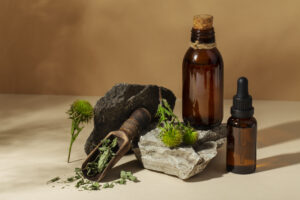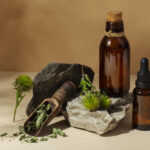In the pursuit of healthy, lustrous locks, many of us turn to the age-old remedy of hair oils. Whether it’s coconut oil, Argan oil, or a blend of essential oils, these natural elixirs have been cherished for their ability to nourish, strengthen, and beautify hair. But what exactly makes hair oils so effective? Let’s delve into the science behind these liquid wonders to understand their mechanisms of action and the benefits they offer.
DISCLAIMER: The information provided in this blog is for educational and informational purposes only and is not intended as medical advice. The content is not intended to diagnose, treat, cure, or prevent any disease. Readers are advised to consult with a qualified healthcare professional regarding their specific health concerns and before starting any herbal remedies or health regimen. While every effort has been made to ensure the accuracy and completeness of the information presented, the author and publisher assume no responsibility for any errors or omissions. The use of herbal remedies and traditional medicine should be undertaken with caution and under the guidance of a qualified healthcare practitioner, especially for individuals with pre-existing medical conditions or those taking medications. The inclusion of specific herbs or formulations in this blog does not imply endorsement or recommendation. Individual responses to herbal remedies may vary, and it is important to consider individual health needs and sensitivities. Always read product labels and instructions carefully before use. By accessing and using this blog, readers acknowledge and agree to the terms of this disclaimer and release the author and publisher from any liability arising from the use or misuse of the information provided.
UNDERSTANDING HAIR STRUCTURE
Before we explore the science of hair oils, it’s essential to understand the structure of our hair. Each strand of hair consists of three main layers: the cuticle, cortex, and medulla. The outermost layer, the cuticle, is composed of overlapping scales that protect the inner layers of the hair shaft. The cortex, located beneath the cuticle, contains proteins, including keratin, which provide strength and structure to the hair. The medulla, the innermost layer, is present in some hair types but not all and contributes to the overall density of the hair strand.
THE ROLE OF LIPIDS
One of the key components of hair oils is lipids, or fatty acids, which play a crucial role in maintaining the health and integrity of the hair. Lipids serve as the building blocks of the hair’s natural oils, known as sebum, which is produced by the sebaceous glands in the scalp. Sebum lubricates the hair shaft, providing moisture and protection against environmental stressors.
When the hair becomes dry or damaged, either due to external factors such as heat styling or chemical treatments or internal factors such as hormonal changes or nutritional deficiencies, the lipid layer of the hair is compromised. This can lead to issues such as dryness, frizz, and breakage. Hair oils help to replenish these lost lipids, restoring moisture and improving the overall condition of the hair.
PENETRATION AND ABSORPTION
One of the reasons why hair oils are so effective is their ability to penetrate the hair shaft and deliver nourishing ingredients directly to the cortex, where they can exert their beneficial effects. The size and structure of the oil molecules play a crucial role in determining their ability to penetrate the hair.
Some oils, such as coconut oil and olive oil, have small molecular sizes that allow them to penetrate deeply into the hair shaft, while others, such as castor oil, have larger molecules that primarily coat the outer surface of the hair. Regardless of their penetration depth, hair oils form a protective film around the hair shaft, helping to seal in moisture and prevent further damage.
MOISTURIZING AND CONDITIONING
One of the primary benefits of hair oils is their moisturizing and conditioning properties. When applied to the hair, oils help to hydrate and soften the hair shaft, making it more flexible and less prone to breakage. This is especially beneficial for dry, damaged, or chemically treated hair, which tends to be more porous and susceptible to moisture loss.
In addition to providing hydration, hair oils also help to smooth the cuticle layer of the hair, reducing frizz and enhancing shine. By filling in gaps and irregularities in the cuticle, oils create a smoother surface texture, allowing light to reflect more evenly off the hair, resulting in a glossy, polished appearance.
NUTRIENT DELIVERY
Hair oils are not only rich in lipids but also contain a variety of vitamins, minerals, and antioxidants that are beneficial for hair health. For example, argan oil is rich in vitamin E, a potent antioxidant that helps to protect the hair from free radical damage and environmental stressors. Jojoba oil contains vitamins B and C, as well as minerals such as zinc and copper, which nourish the hair and promote growth.
When applied to the scalp, hair oils can also stimulate blood circulation, which delivers oxygen and nutrients to the hair follicles, promoting healthy hair growth. Massaging the scalp with oil can also help to loosen dead skin cells and excess sebum, preventing clogged pores and promoting a healthy scalp environment.
CONCLUSION
In conclusion, the effectiveness of hair oils lies in their ability to replenish lost lipids, penetrate the hair shaft, and deliver nourishing ingredients directly to the cortex. By moisturizing, conditioning, and protecting the hair, oils help to improve its overall health, strength, and appearance. Whether used as a pre-shampoo treatment, leave-in conditioner, or styling aid, hair oils offer a natural and effective solution for achieving beautiful, radiant hair.
As with any hair care product, it’s essential to choose high-quality oils that are suitable for your hair type and needs. Experimenting with different oils and application methods can help you find the perfect regimen to unlock the full potential of your hair. So, embrace the science behind hair oils and let nature’s liquid gold transform your tresses into a crowning glory of beauty and vitality.




